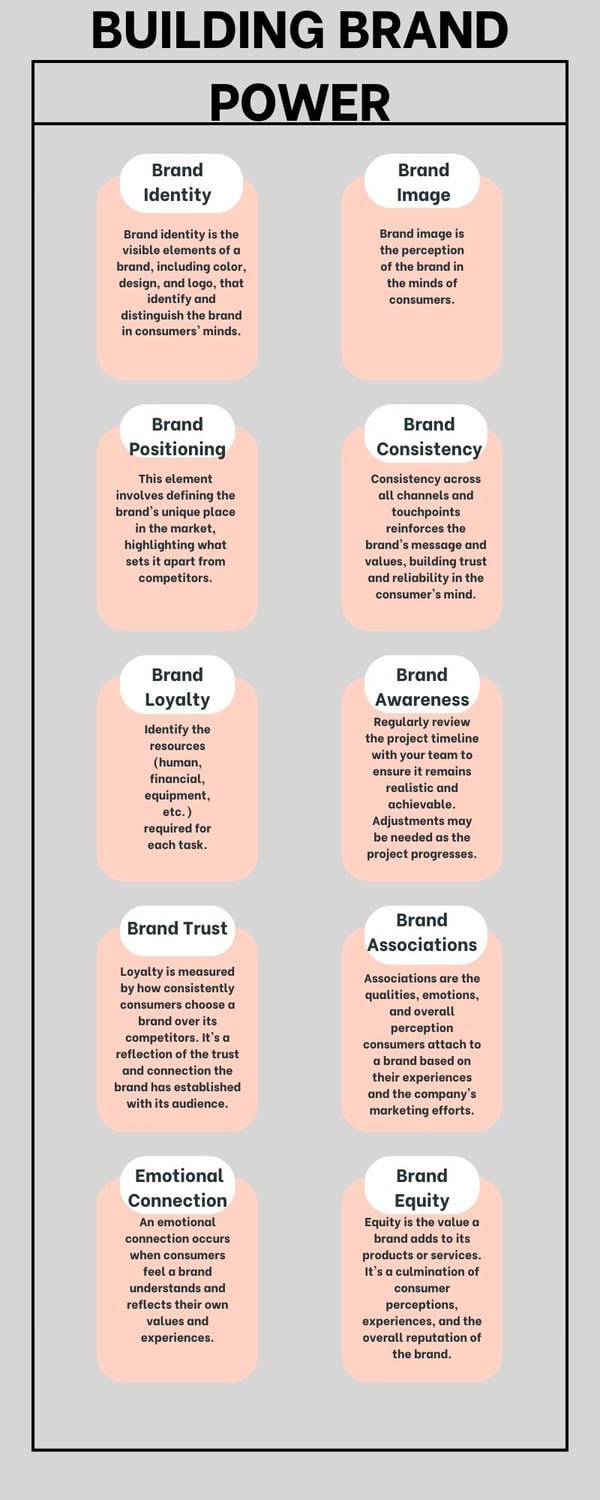In a world brimming with choices, where a stroll down a supermarket aisle presents a myriad of similar options, what compels a consumer to choose one brand over another? This is where the concept of brand power comes into play, transcending mere product attributes and delving into the realms of consumer trust, recognition, and emotional connection.
From the ubiquitous cans of chicken noodle soup to the fierce competition between beverage titans like Pepsi and Coca-Cola, this article aims to demystify brand power, explore its influence on businesses, and provide insights into measuring and harnessing this elusive force.
What is Brand Power?
Brand power is the magnetic force that attracts consumers to a brand, often making a difference in a purchase decision. It's the aura around a brand that resonates with familiarity, reliability, and quality. Brands like Apple and Microsoft exemplify this concept, commanding loyalty and premium pricing not merely for their product features but for the entire brand experience they promise. Brand power is about crafting a narrative so compelling that your brand becomes synonymous with a specific need or desire in the consumer's mind.
How Brand Power Influences Businesses
The influence of brand power on businesses is profound. It shapes consumer perceptions, fosters loyalty, and drives repeat purchases. Brands armed with strong brand power, like Amazon, Under Armour, and McDonald's, don't just survive market fluctuations; they thrive, turning every product or service they offer into a premium experience. Brand power allows businesses to transcend geographic and cultural barriers, adapt to local markets, and still maintain a universally consistent brand image.
Key Elements and How to Build Brand Power
In the vast and competitive landscape of modern commerce, brand power emerges as a pivotal force that can significantly elevate a company's market standing. Brand power isn't just about recognition; it's about fostering a deep connection with consumers, crafting an image of reliability, and creating a perceived value that resonates throughout the market. Here, we explore the ten critical elements that constitute brand power and offer strategies to build and harness this influential asset.

1. Brand Identity
Brand identity is the visible elements of a brand, including color, design, and logo, that identify and distinguish the brand in consumers' minds. It's about crafting a distinctive and memorable image through a unique logo, an appealing color scheme, and other visual elements. A robust brand identity resonates with consumers, fosters recognition, and establishes a strong presence in the market.
To forge a compelling brand identity, businesses must ensure that every visual element aligns harmoniously with the brand's values and message. This encompasses the logo, typography, color palette, and overall visual aesthetics, ensuring consistency across all consumer touchpoints.
2. Brand Image
Brand image is the perception of the brand in the minds of consumers. It encompasses the associations consumers have with the brand based on their experiences, beliefs, and interactions.
Crafting a positive brand image requires delivering consistent quality, maintaining reliability, and ensuring all brand communications and interactions positively reflect the brand's values and promises.
3. Brand Positioning
This element involves defining the brand's unique place in the market, highlighting what sets it apart from competitors. It's about understanding and catering to the specific needs and preferences of the target audience.
Effective brand positioning involves identifying and communicating a clear Unique Selling Proposition (USP) that resonates with the target market, ensuring that the brand's offerings are aligned with consumer needs and preferences.
4. Brand Consistency
Consistency across all channels and touchpoints reinforces the brand's message and values, building trust and reliability in the consumer's mind.
Ensure that the brand's messaging, tone, and visual elements are uniform across all platforms, from digital content to physical packaging, creating a cohesive and recognizable brand presence.
5. Brand Loyalty
Loyalty is measured by how consistently consumers choose a brand over its competitors. It's a reflection of the trust and connection the brand has established with its audience.
Fostering brand loyalty involves providing exceptional customer experiences, engaging with the audience meaningfully, and ensuring the brand consistently meets or exceeds customer expectations.
6. Brand Awareness
Awareness refers to how well consumers recognize and recall a brand. High brand awareness means the brand is top of mind in its category.
Increase brand visibility through strategic marketing and advertising campaigns, leveraging social media, and engaging in community initiatives to keep the brand at the forefront of consumers' minds.
7. Brand Trust
Trust is built when a brand consistently delivers on its promises and maintains transparency in its operations and communications.
Cultivate trust by ensuring product and service quality, engaging in open and honest communication, and addressing consumer feedback promptly and effectively.
8. Brand Associations
Associations are the qualities, emotions, and overall perception consumers attach to a brand based on their experiences and the company's marketing efforts.
Form strategic partnerships, participate in events, and engage in corporate social responsibility initiatives that align with the brand's values and resonate with the target audience.
9. Emotional Connection
An emotional connection occurs when consumers feel a brand understands and reflects their own values and experiences.
Create compelling brand stories, engage in meaningful dialogues with consumers, and ensure the brand's marketing efforts resonate on an emotional level with the audience.
10. Brand Equity
Equity is the value a brand adds to its products or services. It's a culmination of consumer perceptions, experiences, and the overall reputation of the brand.
Strengthen brand equity by maintaining a strong market position, ensuring positive consumer experiences, and continuously monitoring and adapting to consumer needs and market trends.
Measuring the Effectiveness of Brand Power
Understanding your brand's position in the consumer's mind is essential, and brand awareness surveys offer a window into this perspective. These surveys help gauge brand recall and recognition, providing insights into consumer familiarity with your brand.
Employing both aided and unaided questions gives a holistic view of your brand's visibility and perception in the market. Visual elements like logos and packaging play a significant role, and visually aided brand awareness can reveal how these elements contribute to your brand's overall power.
Brand Power Versus Product Power
While product quality is undeniably important, brand power often takes precedence in the consumer's decision-making process. Brands like Amazon have demonstrated that the power of the brand itself can eclipse the individual value of products or services offered.
Brand power is about the total experience a brand promises, turning an ordinary product or service into a part of the consumer's lifestyle and identity.
Success Stories of Brands with Significant Power
Several brands have achieved remarkable success, becoming household names and wielding significant influence in their respective industries. Here are three notable examples:
Apple Inc.
Innovation and Brand Loyalty: Apple has been at the forefront of innovation, particularly in the consumer electronics sector. The introduction of the iPod, iPhone, and iPad revolutionized the way people interact with technology. Apple's success isn't just due to its innovative products but also its ability to create a robust brand ecosystem. The seamless integration between Apple devices, coupled with a dedicated customer base, has led to unparalleled brand loyalty.
Market Capitalization: Apple frequently finds itself among the top companies globally regarding market capitalization, highlighting its financial success and influence in the global market.
Retail and Customer Service: Apple's retail stores provide a unique, high-end shopping experience, contributing significantly to its brand image. The company's focus on customer service and the in-store experience has set it apart from competitors.
Amazon.com
E-commerce Domination: Starting as an online bookstore, Amazon has grown into the largest online retailer in the world. Its vast product selection and services like Amazon Prime have revolutionized the retail industry.
Cloud Computing Leader: Through its subsidiary, Amazon Web Services (AWS), Amazon has become a dominant player in the cloud computing industry, providing a wide range of services to individuals, companies, and governments.
Innovation and Expansion: Amazon's commitment to innovation is evident in its varied business ventures, including hardware (Kindle, Alexa), streaming services (Amazon Prime Video), and even its foray into physical retail (Amazon Go stores).
Coca-Cola
Brand Recognition and Global Reach: Coca-Cola is one of the most recognized and cherished brands worldwide. Its ability to adapt to different cultures and tastes has made it a global icon.
Marketing Prowess: Coca-Cola's marketing strategies have been pivotal in its success. Campaigns like "Share a Coke" and sponsorship deals with major sporting events (FIFA World Cup, the Olympics) have bolstered its brand visibility and appeal.
Product Diversification: While Coca-Cola started with its classic cola beverage, it has successfully diversified its product line to include a wide range of beverages, catering to a broad consumer base and staying relevant in the market.
These brands have demonstrated the power of innovation, strong marketing, and customer engagement in driving success and establishing a significant presence in their respective industries.
Summing up
Brand power is the alchemy that transforms a business from a mere provider of goods or services into an integral part of the consumer's life. It's a multifaceted construct, woven from the threads of trust, recognition, consistency, and emotional resonance.
As businesses navigate the competitive landscape, understanding and harnessing brand power can be the difference between fading into obscurity and rising to iconic status. In the journey to elevate a brand above the rest, recognizing the intricate dance of brand power is not just beneficial; it's imperative.



